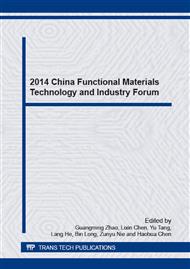p.477
p.485
p.493
p.500
p.503
p.507
p.514
p.520
p.527
Synthesis and Characterization of Isobutyl-Chitosan-Ca(II) Complexes
Abstract:
Through an alkylation reaction under alkaline conditions, isobutyl was introduced to chitosan to form isobutyl-chitosan. Isobutyl-chitosan-Ca (II) complex was synthesized at pH 6.0 by a reaction of isobutyl-chitosan and calcium chloride. The structure of isobutyl-chitosan-Ca (II) complexes was characterized by ultraviolet-visible diffuse reflectance spectrum (UV-Vis) and FT-IR spectrum, and the content of calcium was measured by inductively coupled plasma-optical emission spectrometry (ICP-OES). The FT-IR spectra of isobutyl-chitosan and chitosan showed that structure of isobutyl-chitosan-Ca (II) complexes was obviously different with isobutyl-chitosan. Results of UV spectra showed that the maximum absorption of isobutyl-chitosan and isobutyl-chitosan-Ca (II) were at 310 nm and 324 nm, respectively. The content of calcium was 1.6026%, measured by ICP-OES.
Info:
Periodical:
Pages:
503-506
Citation:
Online since:
December 2014
Authors:
Keywords:
Price:
Сopyright:
© 2015 Trans Tech Publications Ltd. All Rights Reserved
Share:
Citation:


